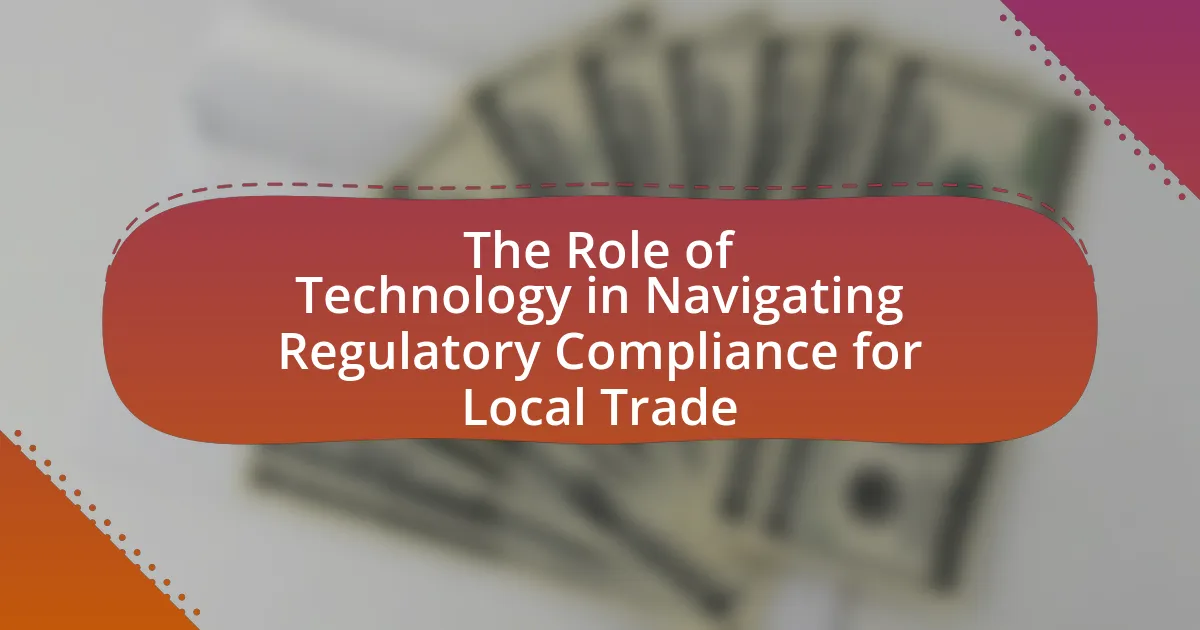Health and Safety Regulations are legal standards aimed at ensuring the safety, health, and welfare of individuals in the workplace. This article examines the impact of these regulations on local trade, highlighting their role in promoting employee safety, reducing workplace hazards, and influencing operational costs for businesses. It discusses the specific regulations relevant to local trade, the variations across different industries, and the importance of compliance for maintaining a positive business reputation. Additionally, the article addresses the challenges local businesses face in adhering to these regulations and outlines best practices for effective compliance, including training programs and regular audits.

What are Health and Safety Regulations?
Health and Safety Regulations are legal standards designed to ensure the safety, health, and welfare of individuals in the workplace. These regulations mandate employers to provide a safe working environment, implement safety measures, and conduct risk assessments to prevent accidents and health issues. For instance, the Occupational Safety and Health Administration (OSHA) in the United States enforces regulations that require employers to adhere to specific safety protocols, which have been shown to reduce workplace injuries by approximately 40% since its establishment in 1970.
How do Health and Safety Regulations impact local businesses?
Health and Safety Regulations significantly impact local businesses by enforcing standards that ensure employee safety and reduce workplace hazards. Compliance with these regulations often requires businesses to invest in safety training, equipment, and procedures, which can lead to increased operational costs. For instance, a study by the Health and Safety Executive in the UK found that businesses that adhere to health and safety regulations experience fewer accidents, resulting in lower insurance premiums and reduced absenteeism. Furthermore, maintaining a safe work environment can enhance a business’s reputation, attracting more customers and potentially increasing profitability.
What specific regulations are most relevant to local trade?
The specific regulations most relevant to local trade include health and safety standards, zoning laws, and licensing requirements. Health and safety standards, such as those enforced by the Occupational Safety and Health Administration (OSHA), ensure that businesses maintain safe working environments, which directly impacts local trade by influencing operational costs and employee productivity. Zoning laws regulate land use and can affect where businesses can operate, thereby shaping the local economic landscape. Licensing requirements, which vary by industry and locality, ensure that businesses comply with legal standards, impacting their ability to trade legally and effectively within the community. These regulations collectively influence the operational framework within which local trade occurs, affecting both compliance costs and market accessibility.
How do these regulations vary by industry?
Health and safety regulations vary significantly by industry due to differing risks and operational practices. For example, the construction industry is subject to stringent regulations regarding fall protection and equipment safety, while the food service industry focuses on sanitation and food handling standards. The Occupational Safety and Health Administration (OSHA) provides specific guidelines tailored to each sector, reflecting the unique hazards present. In 2020, OSHA reported that the construction industry had the highest number of fatalities, necessitating stricter regulations compared to industries like retail, which face different safety challenges. This differentiation ensures that regulations are relevant and effective in mitigating risks specific to each industry.
Why are Health and Safety Regulations important for local trade?
Health and Safety Regulations are crucial for local trade because they ensure the protection of workers and customers, fostering a safe business environment. A safe workplace reduces the risk of accidents and injuries, which can lead to financial losses for businesses due to medical costs, legal fees, and potential fines. For instance, according to the Health and Safety Executive, businesses that prioritize health and safety can see a return of up to £4 for every £1 invested in safety measures. This not only enhances employee morale and productivity but also builds customer trust, ultimately contributing to the sustainability and growth of local trade.
What are the potential consequences of non-compliance?
The potential consequences of non-compliance with health and safety regulations include legal penalties, financial losses, and reputational damage. Legal penalties can manifest as fines or sanctions imposed by regulatory bodies, which can reach thousands to millions of dollars depending on the severity of the violation. Financial losses may arise from increased insurance premiums, costs associated with workplace accidents, or loss of business due to shutdowns mandated by authorities. Reputational damage can lead to a decline in customer trust and loyalty, ultimately affecting sales and market position. For instance, a study by the Health and Safety Executive found that businesses facing non-compliance issues often experience a 30% drop in customer retention rates.
How do these regulations protect employees and consumers?
Health and safety regulations protect employees and consumers by establishing mandatory standards that ensure safe working conditions and product safety. These regulations require employers to implement safety measures, conduct regular inspections, and provide training, which reduces workplace accidents and health risks for employees. For consumers, regulations mandate that products meet safety criteria, thereby minimizing the risk of harm from unsafe goods. For example, the Occupational Safety and Health Administration (OSHA) enforces standards that have led to a significant decrease in workplace fatalities, from 38 worker deaths per day in 1970 to approximately 14 per day in recent years. This demonstrates the effectiveness of regulations in safeguarding both employees and consumers.

What is the relationship between Health and Safety Regulations and local trade performance?
Health and Safety Regulations positively influence local trade performance by creating a safer working environment, which enhances employee productivity and reduces absenteeism. When businesses comply with these regulations, they often experience lower accident rates, leading to fewer disruptions in operations. For instance, a study by the Health and Safety Executive in the UK found that effective health and safety management can lead to a 30% reduction in workplace injuries, which directly correlates with improved operational efficiency and profitability for local businesses. Additionally, a safe environment attracts more customers, as consumers are increasingly aware of and concerned about safety standards, further boosting local trade performance.
How do these regulations influence business operations?
Health and safety regulations significantly influence business operations by imposing standards that ensure employee safety and well-being. These regulations require businesses to implement safety protocols, conduct regular training, and maintain equipment, which can lead to increased operational costs. For instance, a study by the Health and Safety Executive in the UK found that businesses adhering to safety regulations experienced a 30% reduction in workplace accidents, thereby improving productivity and reducing costs associated with employee absenteeism. Compliance with these regulations not only protects employees but also enhances a company’s reputation, potentially leading to increased customer trust and loyalty.
What are the costs associated with implementing these regulations?
The costs associated with implementing health and safety regulations include direct expenses such as compliance costs, training, and equipment upgrades. Compliance costs can range from thousands to millions of dollars depending on the size and nature of the business, as businesses must invest in safety equipment, modify facilities, and ensure ongoing training for employees. For example, a study by the National Safety Council found that businesses can spend an average of $1,000 per employee annually on safety training and equipment. Additionally, indirect costs such as potential fines for non-compliance and lost productivity during the implementation phase can further impact financial resources. These costs collectively influence the overall economic burden on local trade as businesses navigate the regulatory landscape.
How can compliance improve business reputation?
Compliance enhances business reputation by demonstrating a commitment to ethical practices and regulatory standards. When businesses adhere to health and safety regulations, they not only protect their employees and customers but also build trust within the community. For instance, a study by the International Labour Organization found that companies with strong safety compliance records experience fewer accidents and injuries, leading to increased employee morale and customer confidence. This positive perception can result in higher customer loyalty and improved brand image, ultimately contributing to long-term business success.
What role do local governments play in enforcing Health and Safety Regulations?
Local governments are crucial in enforcing Health and Safety Regulations by implementing local ordinances, conducting inspections, and ensuring compliance among businesses. They are responsible for monitoring workplace safety standards, investigating complaints, and providing education and resources to local businesses to promote safe practices. For instance, according to the Occupational Safety and Health Administration (OSHA), local agencies often collaborate with state and federal authorities to enforce regulations effectively, ensuring that businesses adhere to safety protocols that protect workers and the community. This enforcement role is vital for maintaining public health and safety, ultimately influencing the local trade environment positively.
How do local enforcement practices differ from national standards?
Local enforcement practices often differ from national standards in their application and interpretation of health and safety regulations. Local authorities may adapt national guidelines to address specific community needs, resulting in variations in enforcement intensity, compliance requirements, and inspection frequency. For instance, a study by the National Institute for Occupational Safety and Health (NIOSH) highlights that local jurisdictions may prioritize certain industries based on regional economic factors, leading to more stringent enforcement in high-risk sectors compared to national standards that apply uniformly across all sectors. This localized approach can create discrepancies in how regulations are implemented, potentially affecting the overall effectiveness of health and safety measures in local trade.
What support do local governments provide to businesses for compliance?
Local governments provide various forms of support to businesses for compliance with health and safety regulations, including guidance, training programs, and financial assistance. Specifically, they often offer workshops and seminars that educate business owners about regulatory requirements, helping them understand how to meet compliance standards effectively. Additionally, many local governments have dedicated compliance officers or departments that provide one-on-one consultations to assist businesses in navigating complex regulations. Financial support may also be available in the form of grants or low-interest loans aimed at helping businesses implement necessary safety measures. These initiatives are designed to promote a safer working environment while ensuring that local businesses can thrive within the regulatory framework.

What are the challenges faced by local businesses in adhering to Health and Safety Regulations?
Local businesses face several challenges in adhering to Health and Safety Regulations, including limited resources, lack of awareness, and complex compliance requirements. Limited financial and human resources often hinder small businesses from implementing necessary safety measures, as they may lack the budget for training or safety equipment. Additionally, many local business owners may not be fully aware of the specific regulations that apply to their industry, leading to unintentional non-compliance. The complexity of regulations can also pose a significant barrier, as businesses must navigate various local, state, and federal guidelines, which can be overwhelming and time-consuming. These challenges can ultimately affect their operational efficiency and legal standing.
What common obstacles do businesses encounter?
Businesses commonly encounter obstacles such as regulatory compliance, financial constraints, and workforce management. Regulatory compliance, particularly with health and safety regulations, can impose significant costs and operational changes, as evidenced by a study from the National Safety Council, which found that businesses face an average of $1,000 per employee annually to meet safety standards. Financial constraints often limit investment in necessary safety measures, leading to potential liabilities and penalties. Additionally, workforce management challenges, including training and retention of skilled employees, can hinder a business’s ability to maintain compliance and operational efficiency.
How can small businesses effectively manage compliance costs?
Small businesses can effectively manage compliance costs by implementing streamlined processes and leveraging technology. By adopting compliance management software, businesses can automate tracking and reporting, reducing manual labor and minimizing errors. According to a study by the National Federation of Independent Business, 30% of small businesses reported that technology helped them reduce compliance costs significantly. Additionally, small businesses can benefit from regular training sessions for employees to ensure they understand compliance requirements, which can prevent costly violations. Engaging with industry associations can also provide access to resources and shared best practices, further lowering compliance expenses.
What resources are available to help businesses navigate regulations?
Businesses can utilize various resources to navigate regulations, including government websites, industry associations, and legal consultants. Government websites, such as the Occupational Safety and Health Administration (OSHA) and the Small Business Administration (SBA), provide comprehensive guidelines and updates on health and safety regulations. Industry associations often offer tailored resources, including compliance checklists and training programs specific to their sectors. Legal consultants can provide expert advice on regulatory compliance, helping businesses understand their obligations and avoid potential penalties. These resources collectively support businesses in effectively managing regulatory requirements and ensuring compliance.
How can businesses balance compliance with operational efficiency?
Businesses can balance compliance with operational efficiency by integrating compliance processes into their operational workflows. This approach minimizes disruptions while ensuring adherence to regulations. For instance, utilizing technology such as compliance management software can streamline reporting and monitoring, reducing the time and resources spent on compliance tasks. According to a study by the Harvard Business Review, companies that automate compliance processes can achieve up to a 30% reduction in compliance-related costs while maintaining operational efficiency. This demonstrates that effective integration of compliance into daily operations not only meets regulatory requirements but also enhances overall productivity.
What strategies can be implemented to streamline compliance processes?
To streamline compliance processes, organizations can implement automation tools that enhance efficiency and accuracy in regulatory reporting. Automation reduces manual errors and accelerates data collection, allowing for real-time compliance monitoring. For instance, a study by the International Journal of Information Management found that companies using automated compliance systems experienced a 30% reduction in compliance-related costs. Additionally, establishing clear communication channels and regular training sessions for employees ensures that all staff are aware of compliance requirements, further minimizing risks of non-compliance.
How can technology assist in meeting regulatory requirements?
Technology assists in meeting regulatory requirements by automating compliance processes and enhancing data accuracy. For instance, software solutions can track regulatory changes in real-time, ensuring that businesses remain informed and compliant with health and safety regulations. Additionally, data analytics tools can analyze operational practices against regulatory standards, identifying areas of non-compliance and facilitating corrective actions. According to a report by the World Economic Forum, companies utilizing compliance technology have seen a 30% reduction in compliance-related costs, demonstrating the effectiveness of technology in streamlining adherence to regulations.
What best practices can local businesses adopt for effective compliance?
Local businesses can adopt several best practices for effective compliance with health and safety regulations, including conducting regular training sessions for employees, implementing a comprehensive safety management system, and maintaining accurate records of compliance activities. Regular training ensures that employees are aware of safety protocols and understand their responsibilities, which is crucial for minimizing workplace accidents. A comprehensive safety management system helps businesses identify potential hazards and implement preventive measures, thereby reducing risks. Accurate record-keeping not only demonstrates compliance during inspections but also aids in tracking safety performance over time. According to the Occupational Safety and Health Administration (OSHA), businesses that actively engage in safety training and management practices can reduce workplace injuries by up to 40%, highlighting the effectiveness of these best practices.
How can training programs enhance employee awareness of regulations?
Training programs enhance employee awareness of regulations by providing structured education on compliance requirements and best practices. These programs often include interactive elements such as workshops, simulations, and assessments that engage employees and reinforce their understanding of specific regulations. For instance, a study by the National Safety Council found that organizations with comprehensive training programs saw a 30% reduction in workplace incidents, indicating that informed employees are more likely to adhere to safety regulations. Additionally, regular updates and refresher courses ensure that employees remain aware of any changes in regulations, further solidifying their knowledge and compliance.
What role does regular auditing play in maintaining compliance?
Regular auditing is essential for maintaining compliance with health and safety regulations, as it systematically evaluates adherence to established standards. This process identifies gaps in compliance, ensures corrective actions are taken, and reinforces a culture of accountability within organizations. For instance, a study by the Occupational Safety and Health Administration (OSHA) indicates that companies conducting regular audits experience a 20% reduction in workplace incidents, demonstrating the effectiveness of audits in promoting safety and compliance.




